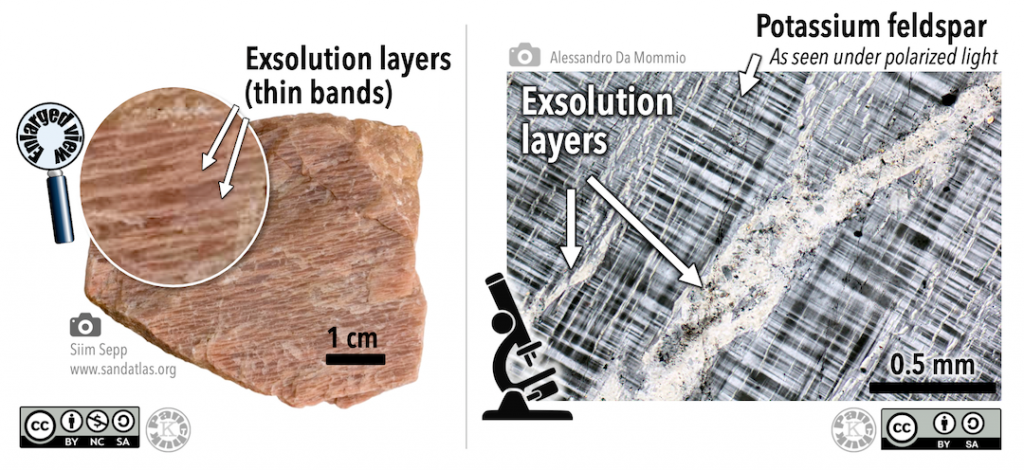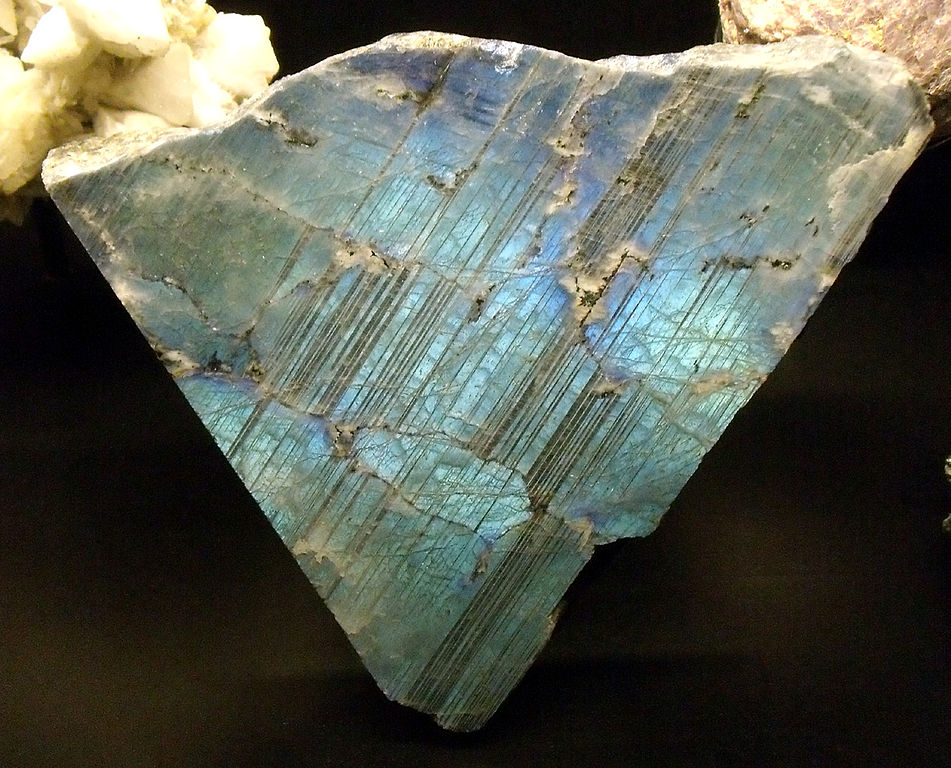Physical Properties of Minerals
Identifying a mineral is a little like playing detective. Minerals are identified by their physical properties. How would you describe the mineral making up the sample in Figure 1.2? You might say that it is shiny, gold, and shaped like cubes. Each of these characteristics is a physical property.
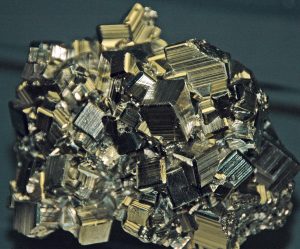
Physical properties can vary within the same minerals, so caution should be applied when identifying minerals based on any one property. Colour is an example of a property that is not a very helpful diagnostic tool in many cases, because some minerals, such as quartz, can come in a variety of colours (Figure 1.3).
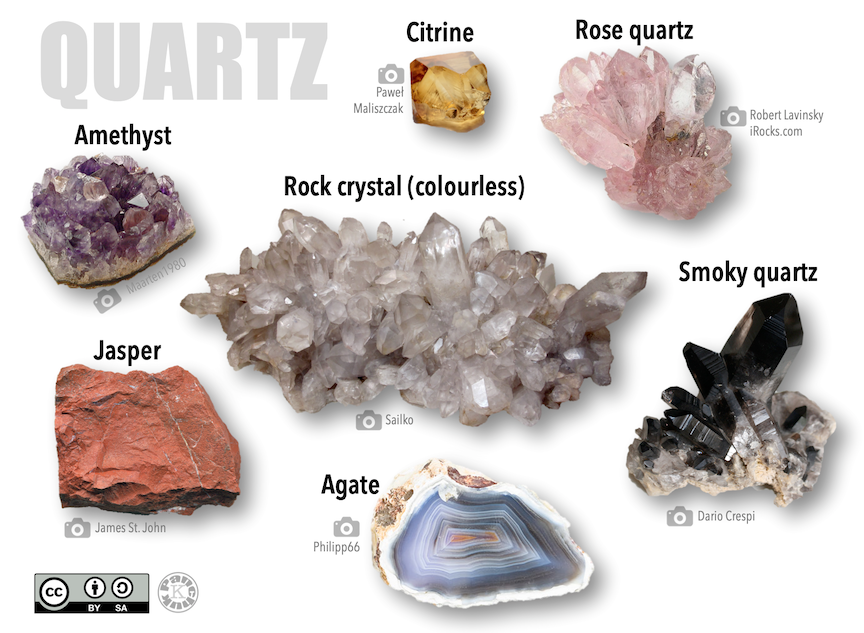
Nevertheless, colour can occasionally be helpful, as in the case of olivine, which comes in shades of olive green (Figure 1.4). This overview covers each of the key physical properties in detail to prepare you to identify the minerals in your kit.
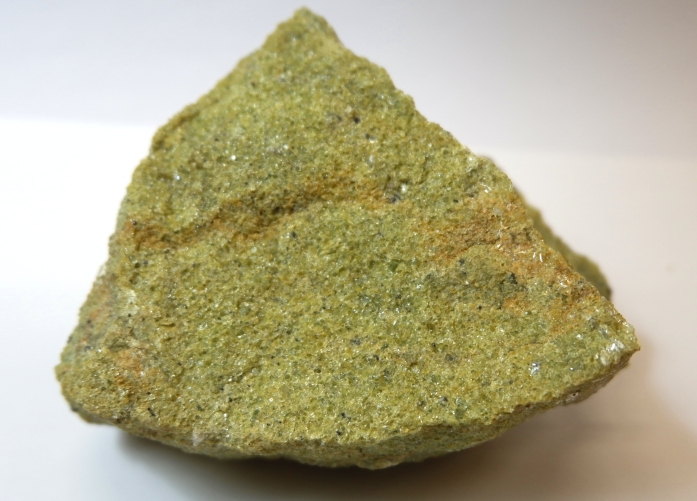
Streak
As you have seen in Figure 1.3, the colour of a mineral specimen is not necessarily a helpful diagnostic property. What may surprise you is that when minerals are powdered, the colour of the powder is consistent between different specimens of a particular mineral, even if the specimens themselves appear to be very different colours. This makes the powder colour very useful for identifying the mineral.
A mineral’s streak is the colour of the powder mark left behind when the mineral is rubbed on an unglazed piece of porcelain called a streak plate (Figure 1.5). Notice that the streak of pyrite in Figure 1.5 is dark grey, even though the pyrite is a dull gold colour.
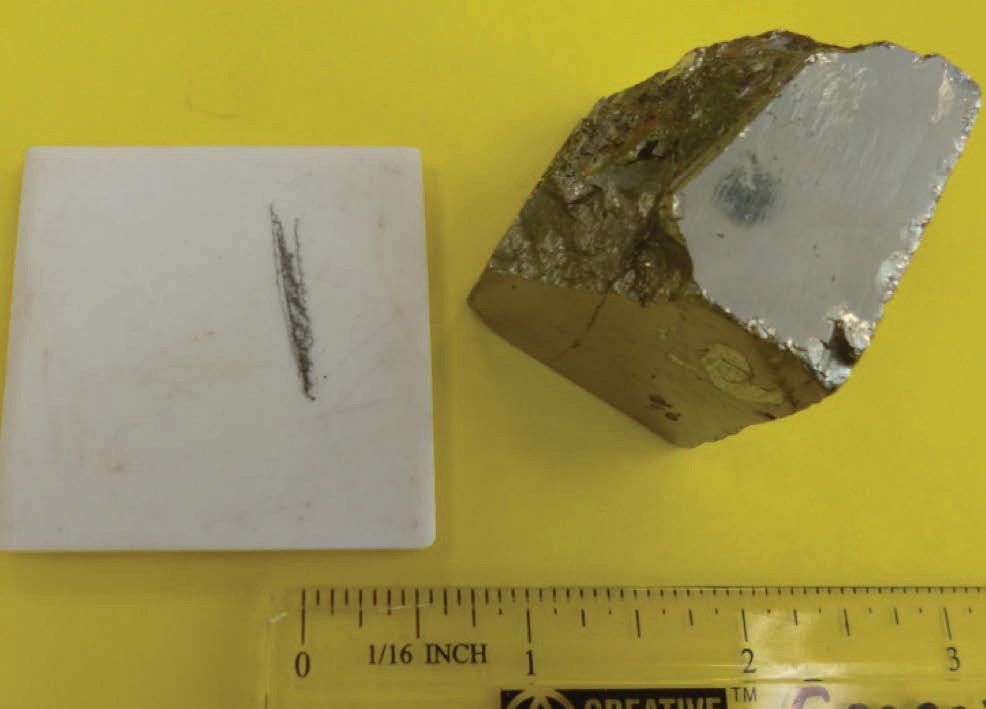
Lustre
Lustre refers to how a mineral’s surface reflects light. In general, lustre can be described as metallic or non-metallic. Minerals with a metallic lustre shine brightly, are opaque, and often have the colour of a metal, such as silver, gold, copper, or brass (Figure 1.6). If a mineral with a metallic lustre becomes tarnished, then a submetallic (or semi-metallic) lustre results.
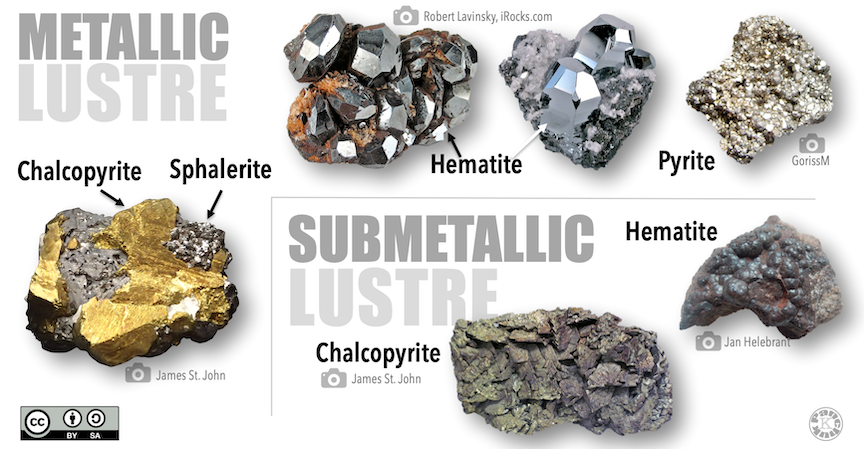
While minerals with a metallic lustre are often shiny, not all shiny minerals are metallic. Bright and shiny minerals can be adamantine or glassy (vitreous). Minerals might have a waxy, silky, or pearl lustre, and some are dull (earthy). Figure 1.7 shows examples of these lustres, but it doesn’t include all of the possibilities. Minerals could have a resinous lustre, or even a greasy lustre!
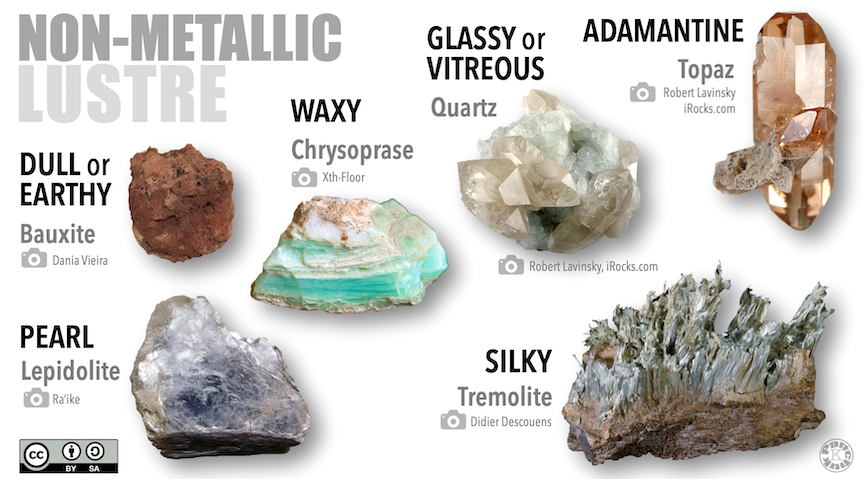
Crystal Form & Mineral Habit
The geometric shape that a mineral naturally grows into is its crystal form. Crystal form reflects the orderly internal arrangement of atoms within the mineral. If minerals have space to grow when they are developing, they will display their crystal form (e.g., Figure 1.8). Ideal growth conditions do not always occur, however. If a mineral encounters another crystal, it will continue to grow according to the same internal atomic arrangement as before, but it will have to follow that pattern within the available space. so many minerals do not display their ideal crystal form due to crowded conditions during growth. Examples of crystal form are shown in Figure 2.8.
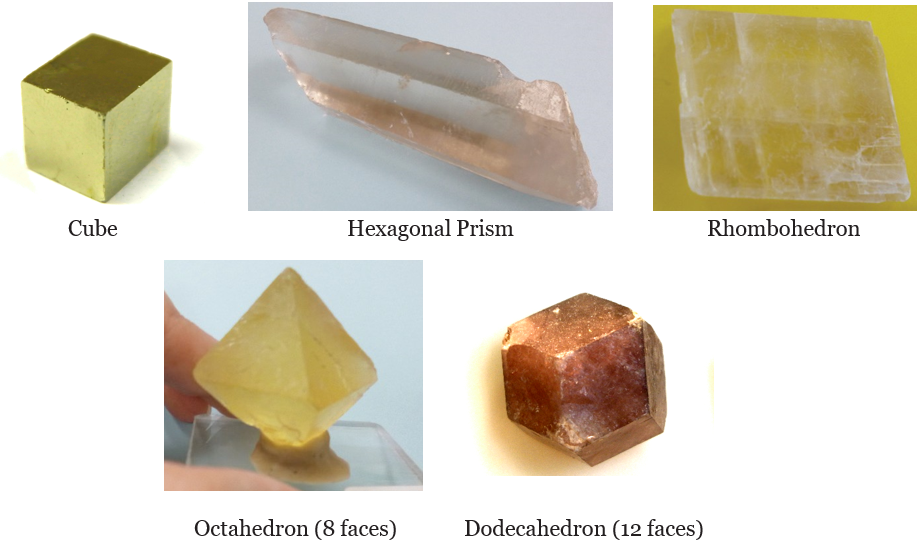
Mineral habit addresses the fact that even though conditions often don’t permit minerals to develop as perfect examples of their crystal form, there are shapes and arrangements that may characterize a particular mineral, either as a single crystal, or when multiple crystals grow together.
Cleavage and Fracture
The chemical bonds between atoms within a mineral are not necessarily the same strength. When the mineral breaks, it will come apart along these zones of weakness. If the zones of weakness are aligned, then the mineral will break along a plane called a cleavage plane. If the mineral has perfect cleavage, the broken surface will be smooth and flat. If the cleavage is poor, then the break will be more irregular.
Minerals for which the zones of weakness are not aligned within a plane, and minerals with bonds that are the same strength in all directions, do not have cleavage. When they break, fracture occurs. Fractured surfaces may exhibit ribbed curved breaks, called choncoidal fracture (Figure 1.9), similar to the curved breaks that form when you get a chip in your windshield.
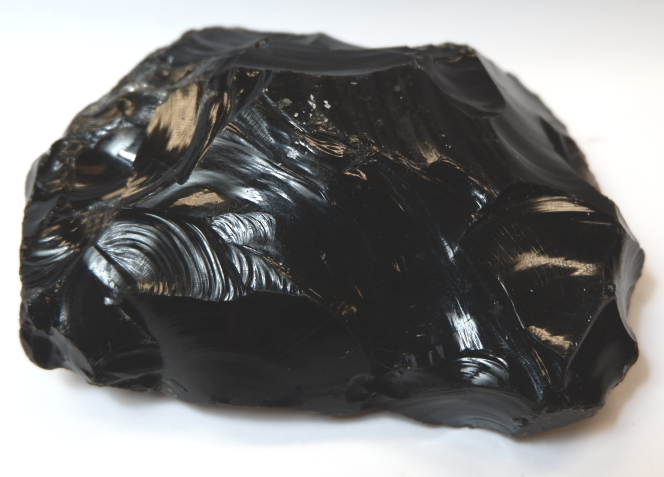
Cleavage or Crystal Form?
You have now seen that flat surfaces on a mineral can be the result of how that mineral grew (its crystal form or mineral habit), or because of how the mineral broke. One way to tell the difference when examining a sample is to see if the flat surface repeats where the sample is broken. Look for a damaged edge or corner and see whether the break is irregular, or whether it happens in steps. The steps might be very tiny, so look carefully to avoid mistaking them for fracture.
Test Your Understanding
Figure 1.10 shows a sample of the mineral pyrite with a mineral habit consisting of a pile of cubes. Are the faces of the cubes a result of cleavage, or is that just how the pyrite crystals grew? Hint: Look at the enlarged view.
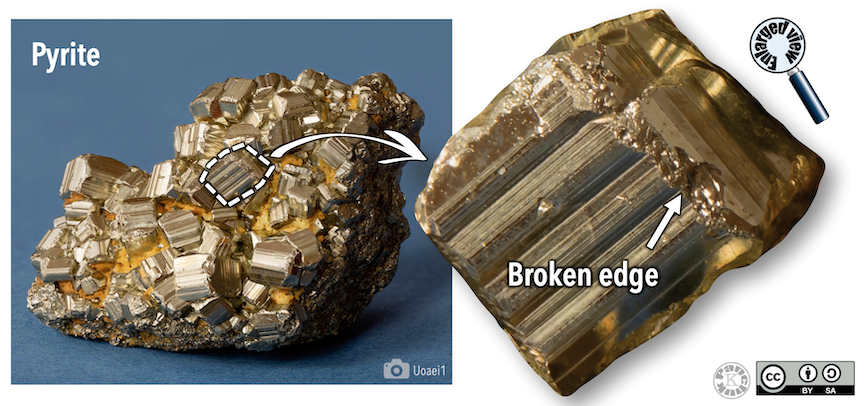
Types of Cleavage
A mineral may have one or more cleavage planes (Figure 1.11). Planes that are parallel to each other are considered the same direction of cleavage, and only count as one. If there is only one direction of cleavage, it is called basal cleavage. Minerals with basal cleavage will break apart in flat sheets. Two directions of cleavage is termed prismatic, while three directions of cleavage at 90o is referred to as cubic. If there are three directions of cleavage not at 90o, the cleavage is rhombohedral. A mineral with four directions of cleavage has octahedral cleavage.
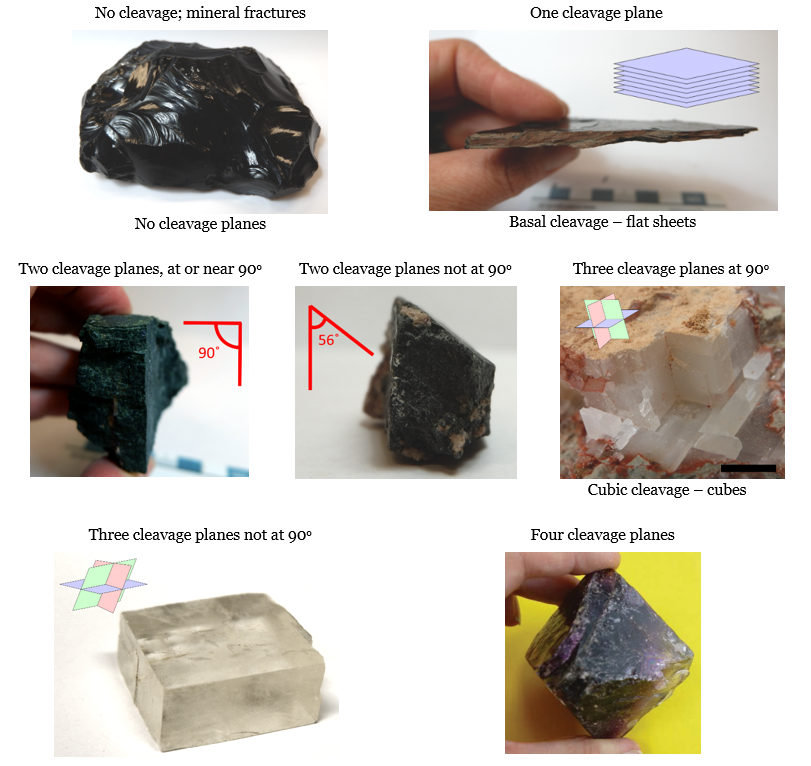
Source: Lyndsay Hauber & Joyce M. McBeth (2018) CC BY 4.0, after Randa Harris (2015) CC BY-SA 3.0 view source
When 2 or more cleavage planes are present, it is important to pay attention to the angle between the cleavage planes. To determine the angle, find a spot where the cleavage planes intersect. This will be an edge or corner. Commonly, cleavage planes will intersect at 60o, 90o (right angles), or 120o.
The angle between cleavage planes is an important characteristic to use when trying to distinguish between the minerals pyroxene and amphibole. Both minerals are black or greenish-black, with similar hardness, making them difficult to tell apart. Cleavage angles in pyroxene are near 90o, so expect it to look boxy and form right angles (Figure 1.12, left), while cleavage angles in amphibole are 60o and 120o, so expect a more bladed or pyramid like appearance (Figure 1.12, right).
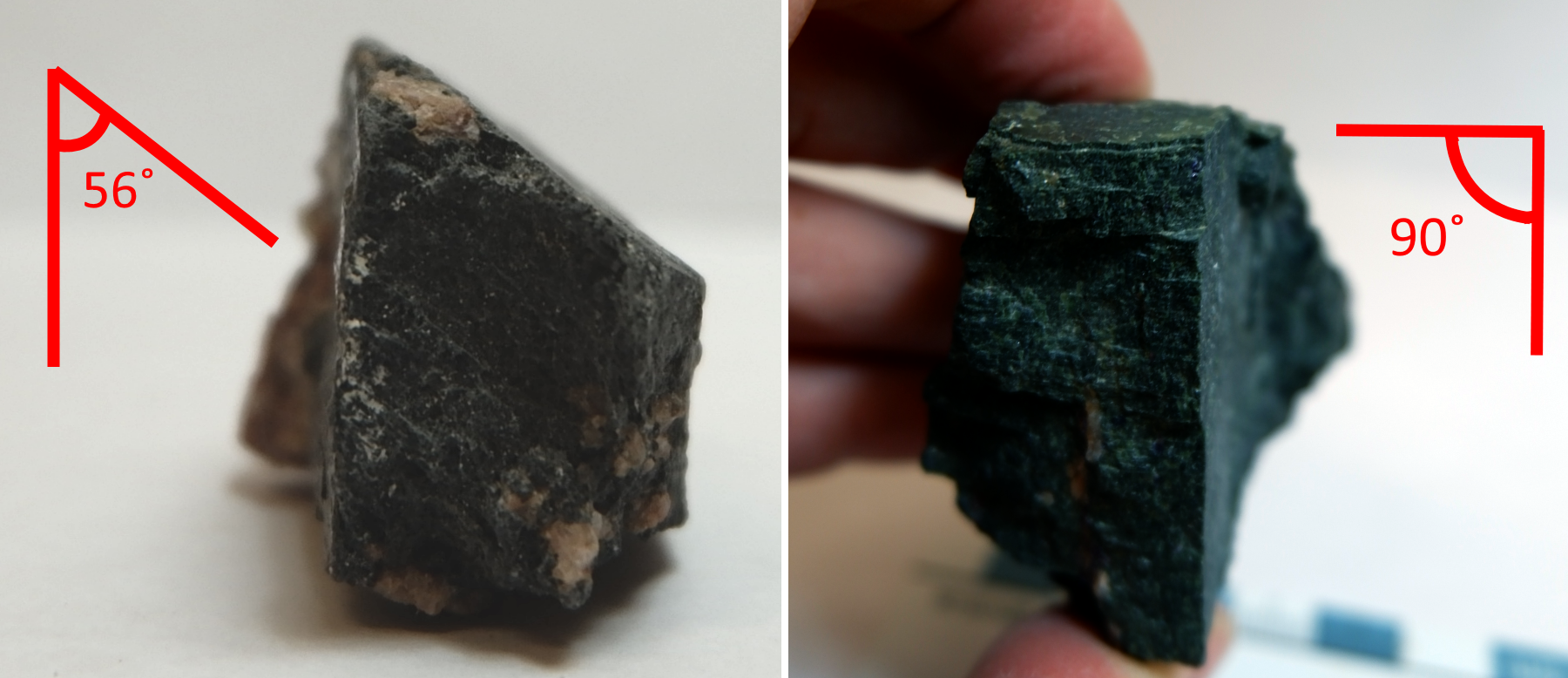
Test Your Understanding
Figure 1.13 shows a mineral that is either amphibole or pyroxene. Your task is to determine which.
- Examine the photo to see if you can spot the cleavage. When you’re done, click the white arrow at the right of the image to see some of the cleavage marked in. Did you identify it correctly?
- Next, answer the questions below Figure 1.13 to indicate whether the mineral is amphibole or pyroxene. Hint: Consult Figure 1.12 if you’re stuck.
Hardness
Hardness refers to the resistance of a mineral to being scratched, and is determined by the strength of the chemical bonds between atoms within a mineral. Hardness is assessed by trying to scratch the mineral with another substance. The material that ends up with a scratch in it is softer; the material that made the scratch is harder.
Hardness is described on a scale of 1 to 10 created by a mineralogist named Friedrich Mohs (Table 1.1). The Mohs hardness scale lists ten minerals in order of relative hardness. Each mineral on the scale can scratch minerals with lower hardness numbers. Your lab kit comes with several items of a known hardness, also listed in Table 1.1 under Lab Kit Items. To test the hardness of a sample, you will scrape it on the testing item, or else try to scratch the testing item against it.
| Table 1.1 Mohs Hardness of Scale |
||
| Mohs Hardness | Mineral | Lab Kit Items |
| 1 | Talc (softest) | |
| 2 | Gypsum | 2.5 – Natural fingernail (supplied by you) |
| 3 | Calcite | 3 – Copper penny; 3.5 – Brass screw |
| 4 | Fluorite | 4 – Nail (steel) |
| 5 | Apatite | 5.5 – Glass plate |
| 6 | Orthoclase Feldspar | 6.5 – Streak plates |
| 7 | Quartz | |
| 8 | Topaz | |
| 9 | Corundum | |
| 10 | Diamond (hardest) | |
Things to keep in mind when testing hardness:
- When using the glass plate or streak plates, always place them on a flat surface rather than holding them in the palm of your hand. If the plate breaks in your hand, you may be injured.
- Don’t confuse mineral powder with a scratch. For example, if there is powder on the glass plate after you scrape a sample across it, brush the powder away with your finger to see whether the the plate is actually scratched. It could be that the powder is from the mineral, in which case the mineral is softer than the plate.
- If you’re not sure about the outcome of a hardness test, try the test on different parts of the sample. On rare occasions, parts of another mineral might be included with the sample you’re testing, giving confusing results.
- Materials of similar hardness have difficulty scratching each other. If you can’t tell whether your sample or the testing item was scratched, that might be why. Try testing the hardness with other materials to check.
Test Your Understanding
Figures 1.14 and 1.15 show the result of hardness tests for two mystery minerals. Refer to the hardness of the lab kit items in Table 1.1 to answer the questions.
Mystery Mineral A
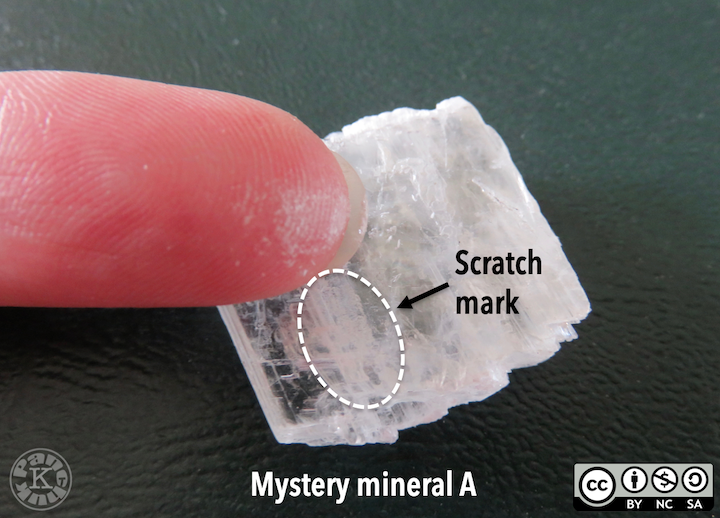
Mystery Mineral B
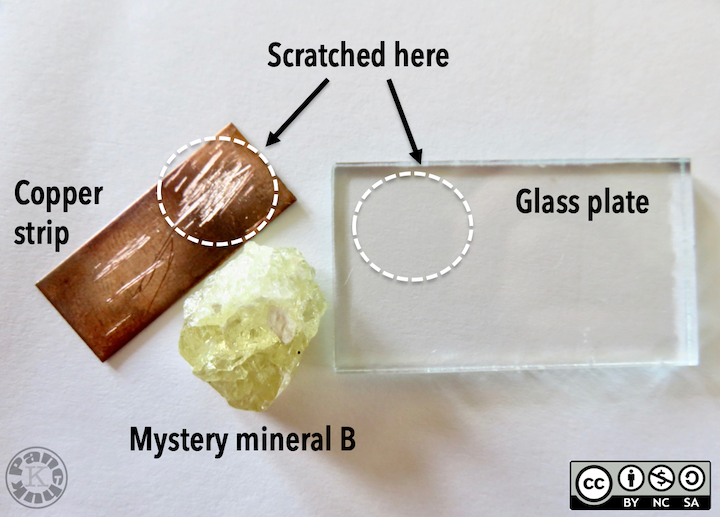
Other Physical Properties for Mineral Identification
There are a variety of other physical properties that can be used for mineral identification. Some are very basic, like taste, smell, or texture. For example:
- Halite will taste salty.
- Sphalerite will release a sulphurous odour when streaked or crushed.
- Talc will feel like a bar of soap.
Tenacity
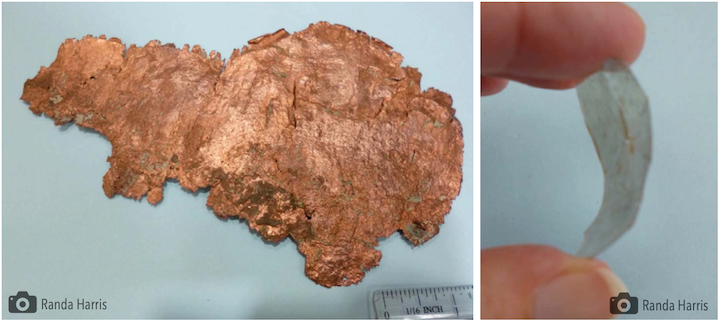
Reaction with Acid
Some minerals react when dilute hydrochloric acid is placed on them. In particular, carbonate minerals—minerals that include the carbonate anion, CO3-2, in their chemical formula—will effervesce or fizz when acid is applied to them because the chemical reaction releases carbon dioxide gas (Figure 1.17). When you test a mineral with acid, be cautious and use just a drop of the acid. Use your magnifying glass to look closely for bubbles. The acid that is typically used for this test is very dilute and will not burn your skin or clothing, but you should still wash your hands after use. Also make sure that you rinse with water and wipe off the acid from the minerals that you test.
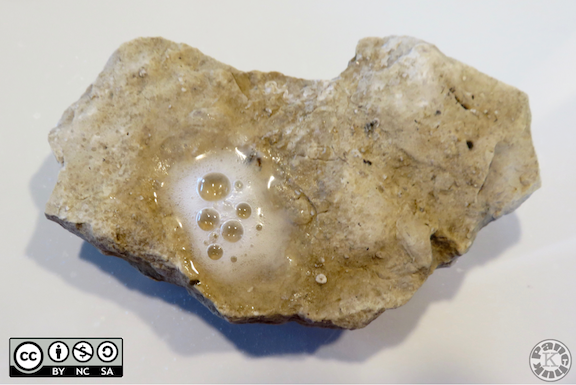
Magnetism
Some minerals, such as the aptly named magnetite, are magnetic. You can test for this by seeing if the mineral attracts the steel nail in your kit, or else by seeing if it will attract another magnet. Note that floppy-style fridge magnets won’t work for this test.
Density or Specific Gravity
Density is an object’s mass per unit volume. In other words, density tells you how heavy something is for its size. For minerals, this property is frequently referred to as specific gravity. Specific gravity is the ratio of a mineral’s weight to the weight of an equal volume of water. A mineral with a specific gravity of 2 would weigh twice as much as water.
Density and specific gravity describe the same characteristic of a material, and will have the same numerical value. The difference is that specific gravity is unitless (a number only) whereas density can have units of g/cm3 or kg/m3. The reason for using two systems that amount to the same thing likely has to do with the ease of the method for measuring specific gravity. This can be accomplished with a scale only, and does not require volume measurements to be made.
Most minerals are heavier than water, and the average specific gravity for all minerals is approximately 2.7 (a density of 2.7 g/cm3). Some minerals are quite heavy, such as pyrite with a specific gravity of 4.9-5.2, native copper, with a specific gravity of 8.8-9.0, and native gold at 19.3. The high specific gravity of gold is a handy characteristic because it makes panning for gold possible—the heavy mineral will stay on the bottom of the pan when you wash out the lighter materials.
Surface Patterns
Some minerals have distinctive surface patterns. Potassium feldspar may display thin light-coloured wavy lines called exsolution layers (or exsolution lamellae). These form because under some conditions, the feldspar crystal unmixes itself into two separate types of feldspar. The majority remains potassium feldspar, but the thin layers are more sodium rich.
